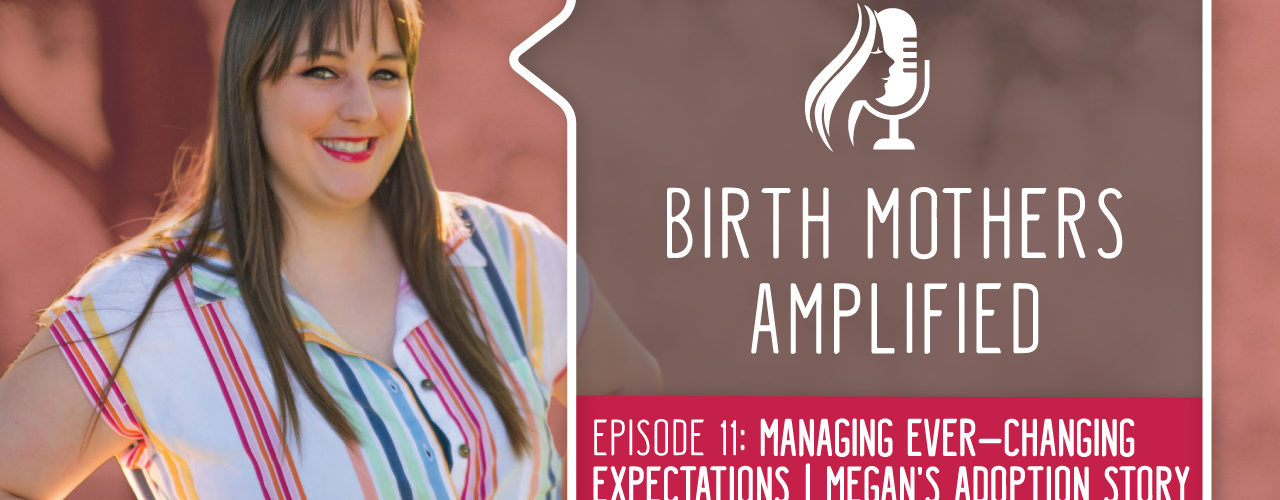First, let me summarize what this episode of Birth Mothers Amplified was about. We got to hear Megan’s story as a birth mother who placed her baby for adoption. She called her mom and they had a family meeting, which included most of the members of her family along with her grandmother, whom she lived with. It was less of a supportive meeting and more of a “Megan, this is what you are going to do.” At first, she was looking into abortion, but after going to the clinic and talking with the doctor about what would take place, she decided there was no way she could do that.
Then, that same weekend, she and her mom met with a friend of her mom who had placed her baby as a teenager. This meeting, and finding an adoption agency that fit her situation the best, were the driving forces of her final decision to place her baby for adoption between six and ten weeks along.
Although Megan wanted to start looking for families as early as two months in, the agency would not allow it until she was seven months along. By this time, she had moved into a dorm that the agency provided where she resided with other women who were expecting, in various stages. She said that it was nice to know that she was not alone, and living with these women helped her to see that. Megan had a specific set of criteria that the prospective adoptive parents needed to have. These included:
- Married at least five years (this was because Megan felt that if a couple was married that long, they were stable)
- Adopted a baby/child before (so the prospective adoptive parents knew how adoption worked)
- Had college degrees
- Preferred a stay-at-home mom
There were other things, like wanting the family to own a dog (she wanted this because she had a dog; this was not a deal-breaker for her). The prospective adoptive parents Megan chose met most of the criteria she had established.
Usually, there is a phone call between the birth mother and the prospective adoptive parents but, in Megan’s case, they met face-to-face two days after she made her choice. She said she knew right away that this family was the right choice. Throughout their weekly phone calls, Megan made it clear that she wanted more than just annual visits and contact through photos, which the prospective adoptive parents said was manageable.
During the 48 hours after she gave birth, she was able to bond and have time alone with her baby but she did contact the adoptive parents to let them know the baby had arrived. During the 30-day waiting period, Megan’s son was in a type of foster care, and she got to see him several times a week. She asked that the prospective adoptive parents understand that the time she got to spend with her baby was not a lot and she could not spend all that time on the phone with them. They seemed to be understanding of her needs.
Prior to placement, Megan used a landline and email to get in touch with the adoptive parents, but as time wore on post-placement, that became more and more obsolete. When the time came for Megan to say goodbye to her son, it hit her hard. She was able to hold her son one more time and even had a photograph taken of them together before she broke into tears.
Once the baby was placed with his adoptive parents, the agreed-upon conditions (visitation more than once a year, photos, letters, etc.) did not take place as they had promised. There was an agreement made between agencies that the adoptive parents decided to stick with, which was different from what they had talked about with Megan. This meant that she would get updates at three, six, and nine months, with a visit at six months should the adoptive parents want it (since they would be in the same area as Megan for finalization). She could also visit when her baby was one year old, and then photo books would be sent yearly after that.
Verbally, Megan was told that the email they gave her could be used to get pictures or just to let them know she was having a hard time post-placement, but in less than a year the expectations changed. She felt that they only told her what she wanted to hear so she would place her baby with them. Since placement, she has had to alter what she expected to happen with the reality of what happens.
The hosts and Megan talk about the importance of considering certain things when making adoption plans, like social media and what can and cannot be posted; in this day and age with the internet and technology, if someone wanted to find you, they would need little information to do so. It should be anticipated that both the birth mother and the adoptive parents give the same level of privacy—out of courtesy, at the very least.
The adoptive parents got angry with Megan for posting a picture of her son on Facebook even though they never discussed what would be allowed when it came to social media. This event ended her updates of her son. Because Megan posted the photo, she still received photos, but she had to drive 30 minutes to look at the pictures, which would not leave the agency. This took place when the baby was almost a year old. Since social media is now a big part of the adoption world, it needs to be talked about at length when making adoption plans.
The hosts, both being birth mothers themselves, had a difficult time understanding how the adoptive parents expected Megan to manage this element of visitation and connection that was never discussed during any of their communications.
Megan gives advice for birth mothers, prospective adoptive parents, and even current adoptive parents on ways to manage the ever-changing world of adoption. Some of her advice included:
- Do not promise something you cannot give. It is difficult enough for both adoptive parents and birth mothers to adjust to new lives without having to readjust after a broken promise.
- Promise things you know you can make good on (if the prospective adoptive parents can only manage a picture every few months and a visit once a year, then be honest).
- If you can give more after you get used to things, do so.
- If there comes a time when adjustments need to be made, communication is key.
One thing that both the hosts and Megan think prospective adoptive parents should keep in mind is as they are entering the adoption process is this: birth mothers are entrusting you with a piece of their heart; they should feel empowered enough to make their wants and needs known when it comes to placement.
The hosts and Megan also talk a little bit about, sometimes it is not the adoptive parents who change the agreement. The birth mother may need to make adjustments if life gets in the way, if she starts a family, and so on. She may be the one to rescind visitation and/or updates.
After listening to Megan’s story and hearing the ups and downs of the past six years of her adoption and post-adoption journey, you realize adoption is definitely not for the faint of heart. There are so many new things, such as social media and the internet, that should be part of the ever-changing discussion when it comes to adoption, especially open and semi-open adoption. This will help to eliminate some of the issues that Megan ran into after her son’s placement.
I found it hard to swallow the way the adoptive parents promised one thing and delivered another, especially after Megan posted a photo of her son on Facebook. It broke my heart that just because technology is a new concept to adoption, her communication became limited. Hearing Megan’s story made me wonder, just as she did, whether the adoptive parents told her what she wanted to hear and kept up communication until they had the baby. After that, it seemed as if they did not care anymore whether there was much contact.
This was a great story of the good, the bad, and the ugly of adoption. Megan handled every aspect of the hand she was dealt with dignity and respect. She is mindful of the adoptive parents, the baby she gave birth to, and anyone else involved, regardless of whether her adoption went to plan. Even after communication had to be through the agencies instead of between herself and the adoptive parents, she still believes that placing her baby was the right thing to do for herself and the baby. She loved her baby enough to know that she would not be able to raise him on her own. Even though her family was adamant about adoption, ultimately the decision was hers.
Another thing that I liked about Megan’s story is that she was able to live in a dorm with other women going through the same thing as her, although at different stages. There was one birth mother that lived in her dorm who gave birth within a couple of days of Megan, so she had someone to talk to who understood exactly where she was coming from at that point in her life. She had a dorm full of birth mothers who knew how she felt and could be her outlet should she need to talk, cry, or get emotions off her chest.
I liked how the hosts were birth mothers themselves so they knew how Megan felt to some extent, even though every story is different. I liked that they gave her space to tell her own story and answer questions in her own way. I liked that they played devil’s advocate throughout the podcast so that anyone watching could see that no one involved in this story was “bad.” They were all doing what they thought best for the baby.
I also liked that there was laughter and everyone was at ease throughout the video. It looked more like friends talking than an interview, in a sense. That might be because all three women had been in the same position at some point in their lives so they understood each other.
I feel bad for Megan though, because she missed out on so much more of her son’s life just because there was not a written agreement in place. Where there is technology involved during this day and age, I feel that it’s important for a birth mother and prospective adoptive parents to have a contract detailing their open adoption. In Megan‘s case, that would mean that she would have gotten what she asked for, which was a lot more than she got. It would also mean that everyone involved in the adoption would know what to expect about social media use. Everyone needs to be on the same page so they can do what is best for the birth mother and the child.
Hearing stories from birth mothers like Megan makes me wonder if I would have what it takes to place my baby with strangers. There has to be some level of trust in the agency chosen, in the prospective adoptive parents, and in oneself to KNOW that adoption is the best decision. It would not be a decision that I would want to make, but in Megan’s case, she loved her baby so much that she knew she needed to place him.
Are you considering placing a child for adoption? Do you want more choices with your adoption plan? Do you want to regain more control in your life? Visit Adoption.org or call 1-800-ADOPT-98. We can help you put together an adoption plan that best meets your needs.



